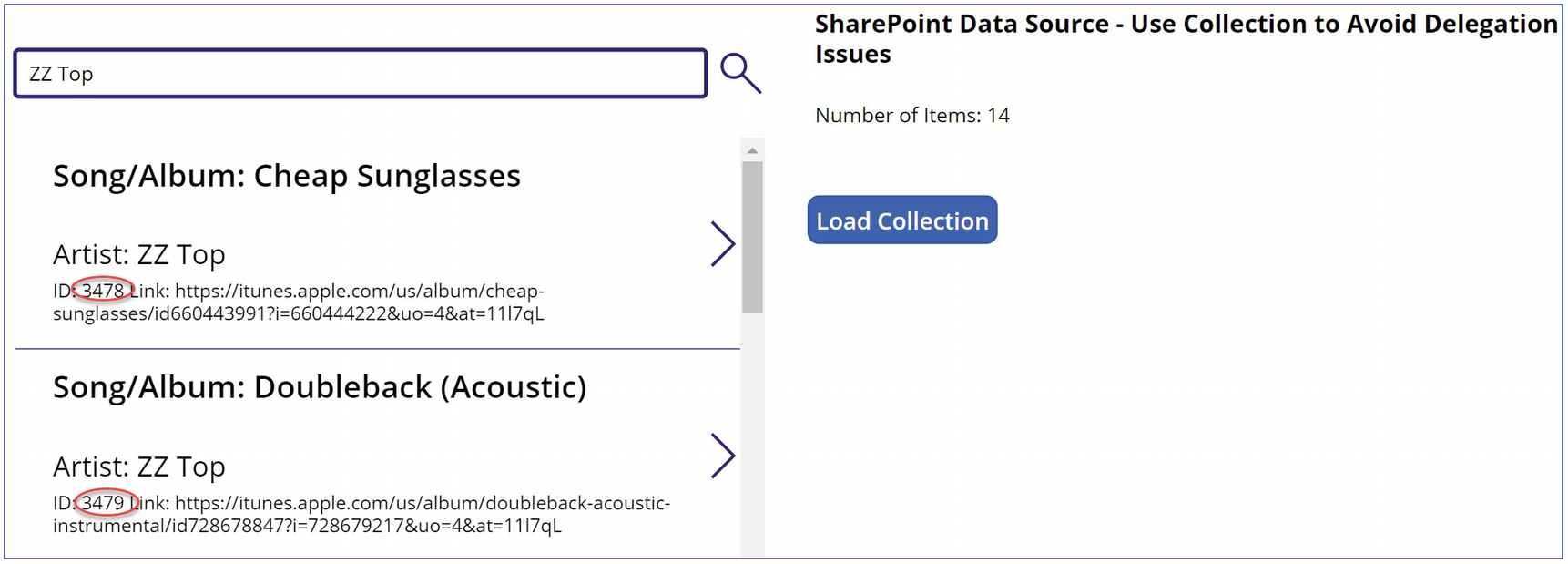In this chapter, we look at how to address a major issue for Power App developers – delegation. This is a huge challenge for the most common types of applications we develop, those with SharePoint data sources. Not being limited to 500 or 2000 records is a huge improvement for these applications.
Delegation is where the expressiveness of Power Apps formulas meets the need to minimize data moving over the network. In short, Power Apps will delegate the processing of data to the data source, rather than moving the data to the app for processing locally.
Things get challenging when we want to perform a task like Filter() with parameters that don’t support delegation. This chapter will demonstrate this issue and then show you a nice workaround.
Demonstrating Delegation Issues with Excel

A table of 4 columns and 16 rows. The column headers are group, song, album, and link.
Music Genius Excel Data Source

A screenshot of a data tab. The tab lists options such as add data with select a data source option. A cursor points to excel online and is highlighted.
Adding the Excel Online Data Source
Since there is no index column in the table, the Excel Online connector will create one for us. But we are not able to see it programmatically and thus can’t use it for our “getting around delegation” solution. But we could have added one and used the same solution as we will show later for SharePoint.

A screenshot of an excel data source with no delegation issues. The source lists the names of 3 songs with the album, artist, and link.
Excel Example with No Delegation Issues

A screenshot of an excel data source with delegation issues. A cursor points to the delegation warning and the number of items, 500 is highlighted.
Delegation Warning with the Or Operator

A screenshot of a settings panel. The options listed for the general option under settings are icon, background fill, icon fill, auto-save, and row limit.
Data Row Limit Setting in Power Apps
We can increase this value to 2000, but we are stuck beyond that. Power Apps goes ahead and grabs that number of records, but all filtering occurs with just those 500 or 2000 records.
Demonstrating Delegation Issues with SharePoint
Before we copy our spreadsheet into a SharePoint list and demonstrate the delegation issue, we skip forward toward our solution4 by noting that we need a numeric column other than the SharePoint list’s Id column in order to read our data source and load it into a collection. For that, we will need a Power Automate flow to run each time we create a SharePoint list item. We might as well create that first so we get this ID_Numeric column to load for each row we paste in.

A screenshot of build an automated cloud flow tab. The tab has a flow name, a checkbox for when an item is created, and a create option at the bottom.
Creating the Power Automate Flow to Update ID_Numeric

A screenshot of adjacent tabs. The tab titled when an item is created points to choose an operation box. A cursor points to the SharePoint option under operation.
Selecting SharePoint Actions

A screenshot of the SharePoint tab. A cursor points to the update item option under actions.
Updating the SharePoint Item

A screenshot of the update item tab. A cursor points to I D under dynamic content on the right. Arrows from I D point to I D and I D numeric of the item tab.
Adding ID to both the ID and ID_Numeric columns
We need to give values for each required column (shown by the * to the left of the column name). We choose ID for both the Id column5 AND the new ID_Numeric column.

A screenshot of a tab with options and the new option highlighted. A cursor points to a box at the bottom to add a new item.
Pasting Excel Data into the SharePoint List

A screenshot of a tab of a 28-day run history. The history has 3 columns and 7 rows. The column headers are the start, duration, and status.
Power Automate Flow Run History

A screenshot of Share Point data source issues. The Screens option under Tree view on the left is highlighted. On the right is a load collection button.
Selecting the LoadCollectionButton in the OnVisible Event
Load Collection Code : Reset
We start with some comments and then Refresh our data source. This is needed in case we or another user recently added, edited, or deleted a record. We then clear all the variables/collections that we use in the code to come. linksCollection is our final output and what we will use in our filter. Since it is a collection internal to Power Apps, it does not have the same delegation restrictions as our Excel or SharePoint data sources.8
Load Collection Code: Generate colNumTemp

A screenshot of a collections panel. A cursor points to the col Num temp option under collections. col Num temp has values from 1 to 5 on the right.
The first five items in the colNumTemp collection
Load Collection Code: Generate colNumbersTable

A screenshot of the collections panel. col Dummy option under collections is highlighted. On the right, the dummy lists 5 items marked by 1.
The colDummy collection

A screenshot of a collections panel. col Numberstable option under collections is highlighted. colNumberstable has numbers from 1 to 5 on the right.
The colNumbersTable collection
The inside loop runs ten more times, giving us 100 items in both colDummy and colNumbers. The outside loop runs ten times as well, leading to 1000 items in both collections.
Load Collection Code: Set Variables
Looking first at the FirstRecord variable , the Sort() function takes three parameters: the table, the formula, and an optional sort order (Ascending or Descending). Power Apps again delegates this operation to the data source (SharePoint in this case), but luckily SharePoint doesn’t impose the 500- or 2000-item cap in this case. Since we want the first record, we sort Ascending. Our formula is to do our sorting by the ID column. We then use the First() function to grab the first item. For LastRecord, we just change the sort to Descending, which puts the highest ID first.10

A screenshot of a variables panel. Use the collection to avoid delegation under the variables highlighted. On the right are options to select a variable.
FirstRecord , LastRecord, and Iterations Variables
Our last variable, varCounter, stores which ID we are on. We name its value min_Num and set it to FirstRecord.ID. We can already guess that we will loop through sets of records and update this variable to keep track of where we are.
Load Collection Code: Loop to Read Records
Working from the inside, the FirstN() function takes a table as the first parameter and the number of records to return as the second parameter. As we saw earlier, colNumbersTable has eight items in our case. colIterations starts with 0 rows and adds a row each time. So we read one record the first time, two the second time, and so forth. Since we get the Last() record and then grab its Number value, this will be 1, 2, 3, etc.
For min_Num, we refer back to Listing 11-4 to note that varCounter.min_Num means the ID of our FirstRecord variable. So this will be 1 the first time around. To get max_Num, we add 499 to it. It is important that this is one less than the value we used in defining our Iterations variable in Listing 11-4. That was 500 in our case.

A screenshot of a collections panel. The collterations option under collections is highlighted. On the right, collterations has num, max n, and min n table.
The colIterations collection
The first time around, we are in the first row and max_Num will be 500. varCounter.min_Num will equal that value + 1 (e.g., 501).
The ForAll() loop will start again and jump to populate the next row of colIterations with the first five items showing in Figure 11-17.
Load Collection Code: Creating linksCollection
The Final Result

A screenshot of the SharePoint data source issues. I Ds 3478 and 3479 of song slash album are highlighted. Load collection button is on the right.
Power App showing records above the delegation limit
Summary
In this chapter, we learned how to use Power App collections and methods like Collect(), ClearCollect(), ForAll(), and Patch() to avoid the dreaded delegation issues with SharePoint or Excel data sources. While there is a bit of code, you will be able to breathe a sigh of relief once you have this nailed down. Otherwise, what looked to be the perfect solution to a key business problem instead could fail once you exceeded 2000 records. Once you have this technique at your disposal, you can then look closely at your data to decide when it makes sense to add this extra step to your applications.
